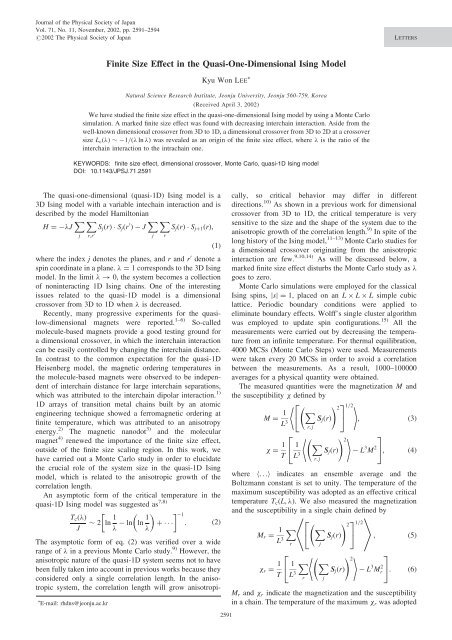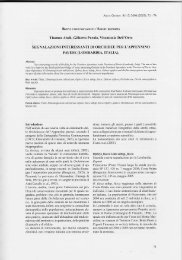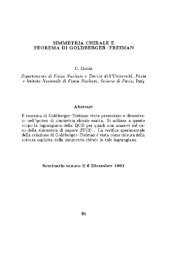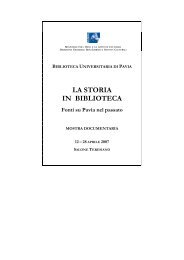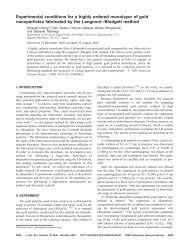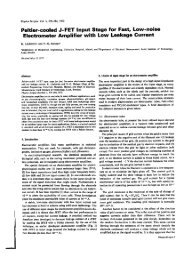Finite Size Effect in the Quasi-One-Dimensional Ising Model
Finite Size Effect in the Quasi-One-Dimensional Ising Model
Finite Size Effect in the Quasi-One-Dimensional Ising Model
Create successful ePaper yourself
Turn your PDF publications into a flip-book with our unique Google optimized e-Paper software.
Journal of <strong>the</strong> Physical Society of Japan<br />
Vol. 71, No. 11, November, 2002, pp. 2591–2594<br />
#2002 The Physical Society of Japan<br />
<strong>F<strong>in</strong>ite</strong> <strong>Size</strong> <strong>Effect</strong> <strong>in</strong> <strong>the</strong> <strong>Quasi</strong>-<strong>One</strong>-<strong>Dimensional</strong> Is<strong>in</strong>g <strong>Model</strong><br />
Kyu Won LEE<br />
Natural Science Research Institute, Jeonju University, Jeonju 560-759, Korea<br />
(Received April 3, 2002)<br />
We have studied <strong>the</strong> f<strong>in</strong>ite size effect <strong>in</strong> <strong>the</strong> quasi-one-dimensional Is<strong>in</strong>g model by us<strong>in</strong>g a Monte Carlo<br />
simulation. A marked f<strong>in</strong>ite size effect was found with decreas<strong>in</strong>g <strong>in</strong>tercha<strong>in</strong> <strong>in</strong>teraction. Aside from <strong>the</strong><br />
well-known dimensional crossover from 3D to 1D, a dimensional crossover from 3D to 2D at a crossover<br />
size Lcð Þ 1=ð ln Þ was revealed as an orig<strong>in</strong> of <strong>the</strong> f<strong>in</strong>ite size effect, where is <strong>the</strong> ratio of <strong>the</strong><br />
<strong>in</strong>tercha<strong>in</strong> <strong>in</strong>teraction to <strong>the</strong> <strong>in</strong>tracha<strong>in</strong> one.<br />
KEYWORDS: f<strong>in</strong>ite size effect, dimensional crossover, Monte Carlo, quasi-1D Is<strong>in</strong>g model<br />
DOI: 10.1143/JPSJ.71.2591<br />
The quasi-one-dimensional (quasi-1D) Is<strong>in</strong>g model is a<br />
3D Is<strong>in</strong>g model with a variable <strong>in</strong>techa<strong>in</strong> <strong>in</strong>teraction and is<br />
described by <strong>the</strong> model Hamiltonian<br />
H ¼ J X X<br />
SjðrÞ Sjðr 0 Þ J X X<br />
SjðrÞ Sjþ1ðrÞ;<br />
j<br />
r;r 0<br />
ð1Þ<br />
where <strong>the</strong> <strong>in</strong>dex j denotes <strong>the</strong> planes, and r and r0 denote a<br />
sp<strong>in</strong> coord<strong>in</strong>ate <strong>in</strong> a plane. ¼ 1 corresponds to <strong>the</strong> 3D Is<strong>in</strong>g<br />
model. In <strong>the</strong> limit ! 0, <strong>the</strong> system becomes a collection<br />
of non<strong>in</strong>teract<strong>in</strong>g 1D Is<strong>in</strong>g cha<strong>in</strong>s. <strong>One</strong> of <strong>the</strong> <strong>in</strong>terest<strong>in</strong>g<br />
issues related to <strong>the</strong> quasi-1D model is a dimensional<br />
crossover from 3D to 1D when is decreased.<br />
Recently, many progressive experiments for <strong>the</strong> quasilow-dimensional<br />
magnets were reported. 1–6) So-called<br />
molecule-based magnets provide a good test<strong>in</strong>g ground for<br />
a dimensional crossover, <strong>in</strong> which <strong>the</strong> <strong>in</strong>tercha<strong>in</strong> <strong>in</strong>teraction<br />
can be easily controlled by chang<strong>in</strong>g <strong>the</strong> <strong>in</strong>tercha<strong>in</strong> distance.<br />
In contrast to <strong>the</strong> common expectation for <strong>the</strong> quasi-1D<br />
Heisenberg model, <strong>the</strong> magnetic order<strong>in</strong>g temperatures <strong>in</strong><br />
<strong>the</strong> molecule-based magnets were observed to be <strong>in</strong>dependent<br />
of <strong>in</strong>tercha<strong>in</strong> distance for large <strong>in</strong>tercha<strong>in</strong> separations,<br />
which was attributed to <strong>the</strong> <strong>in</strong>tercha<strong>in</strong> dipolar <strong>in</strong>teraction. 1)<br />
1D arrays of transition metal cha<strong>in</strong>s built by an atomic<br />
eng<strong>in</strong>eer<strong>in</strong>g technique showed a ferromagnetic order<strong>in</strong>g at<br />
f<strong>in</strong>ite temperature, which was attributed to an anisotropy<br />
energy. 2) The magnetic nanodot 3) and <strong>the</strong> molecular<br />
magnet 4) renewed <strong>the</strong> importance of <strong>the</strong> f<strong>in</strong>ite size effect,<br />
outside of <strong>the</strong> f<strong>in</strong>ite size scal<strong>in</strong>g region. In this work, we<br />
have carried out a Monte Carlo study <strong>in</strong> order to elucidate<br />
<strong>the</strong> crucial role of <strong>the</strong> system size <strong>in</strong> <strong>the</strong> quasi-1D Is<strong>in</strong>g<br />
model, which is related to <strong>the</strong> anisotropic growth of <strong>the</strong><br />
correlation length.<br />
An asymptotic form of <strong>the</strong> critical temperature <strong>in</strong> <strong>the</strong><br />
quasi-1D Is<strong>in</strong>g model was suggested as 7,8)<br />
Tcð Þ<br />
J<br />
2 ln 1<br />
ln ln 1 þ<br />
j<br />
r<br />
1<br />
: ð2Þ<br />
The asymptotic form of eq. (2) was verified over a wide<br />
range of <strong>in</strong> a previous Monte Carlo study. 9) However, <strong>the</strong><br />
anisotropic nature of <strong>the</strong> quasi-1D system seems not to have<br />
been fully taken <strong>in</strong>to account <strong>in</strong> previous works because <strong>the</strong>y<br />
considered only a s<strong>in</strong>gle correlation length. In <strong>the</strong> anisotropic<br />
system, <strong>the</strong> correlation length will grow anisotropi-<br />
E-mail: rhdns@jeonju.ac.kr<br />
2591<br />
cally, so critical behavior may differ <strong>in</strong> different<br />
directions. 10) As shown <strong>in</strong> a previous work for dimensional<br />
crossover from 3D to 1D, <strong>the</strong> critical temperature is very<br />
sensitive to <strong>the</strong> size and <strong>the</strong> shape of <strong>the</strong> system due to <strong>the</strong><br />
anisotropic growth of <strong>the</strong> correlation length. 9) In spite of <strong>the</strong><br />
long history of <strong>the</strong> Is<strong>in</strong>g model, 11–13) Monte Carlo studies for<br />
a dimensional crossover orig<strong>in</strong>at<strong>in</strong>g from <strong>the</strong> anisotropic<br />
<strong>in</strong>teraction are few. 9,10,14) As will be discussed below, a<br />
marked f<strong>in</strong>ite size effect disturbs <strong>the</strong> Monte Carlo study as<br />
goes to zero.<br />
Monte Carlo simulations were employed for <strong>the</strong> classical<br />
Is<strong>in</strong>g sp<strong>in</strong>s, jsj ¼1, placed on an L L L simple cubic<br />
lattice. Periodic boundary conditions were applied to<br />
elim<strong>in</strong>ate boundary effects. Wolff’s s<strong>in</strong>gle cluster algorithm<br />
was employed to update sp<strong>in</strong> configurations. 15) All <strong>the</strong><br />
measurements were carried out by decreas<strong>in</strong>g <strong>the</strong> temperature<br />
from an <strong>in</strong>f<strong>in</strong>ite temperature. For <strong>the</strong>rmal equilibration,<br />
4000 MCSs (Monte Carlo Steps) were used. Measurements<br />
were taken every 20 MCSs <strong>in</strong> order to avoid a correlation<br />
between <strong>the</strong> measurements. As a result, 1000–100000<br />
averages for a physical quantity were obta<strong>in</strong>ed.<br />
The measured quantities were <strong>the</strong> magnetization M and<br />
<strong>the</strong> susceptibility def<strong>in</strong>ed by<br />
M ¼ 1<br />
L3 * 2 ! 3<br />
2<br />
1=2+<br />
X<br />
4 SjðrÞ 5 ; ð3Þ<br />
¼ 1<br />
T<br />
r; j<br />
1<br />
L3 2 * ! 2+<br />
X<br />
4 SjðrÞ<br />
r; j<br />
L 3 M 2<br />
3<br />
5; ð4Þ<br />
where h...i <strong>in</strong>dicates an ensemble average and <strong>the</strong><br />
Boltzmann constant is set to unity. The temperature of <strong>the</strong><br />
maximum susceptibility was adopted as an effective critical<br />
temperature TcðL; Þ. We also measured <strong>the</strong> magnetization<br />
and <strong>the</strong> susceptibility <strong>in</strong> a s<strong>in</strong>gle cha<strong>in</strong> def<strong>in</strong>ed by<br />
Mr ¼ 1<br />
L3 X<br />
r<br />
r ¼ 1<br />
T<br />
2<br />
4<br />
X<br />
SjðrÞ<br />
j<br />
! 2<br />
3<br />
5<br />
1<br />
L3 2 * ! 2+<br />
X X<br />
4<br />
SjðrÞ<br />
r<br />
j<br />
1=2<br />
; ð5Þ<br />
L 3 M 2 r<br />
LETTERS<br />
3<br />
5: ð6Þ<br />
Mr and r <strong>in</strong>dicate <strong>the</strong> magnetization and <strong>the</strong> susceptibility<br />
<strong>in</strong> a cha<strong>in</strong>. The temperature of <strong>the</strong> maximum r was adopted
2592 J. Phys. Soc. Jpn., Vol. 71, No. 11, November, 2002 LETTERS K. W. LEE<br />
as an effective critical temperature TrðL; Þ <strong>in</strong> a cha<strong>in</strong>.<br />
Tcð Þ and Trð Þ are <strong>the</strong> critical temperatures <strong>in</strong> <strong>the</strong><br />
statistical limit, L !1. Trð Þ does not dist<strong>in</strong>guish whe<strong>the</strong>r<br />
a 3D long-range order or a 1D long-range order <strong>in</strong>duced <strong>the</strong><br />
long range order <strong>in</strong> a cha<strong>in</strong>. In <strong>the</strong> 3D limit ! 1, Trð Þ<br />
becomes equal to <strong>the</strong> 3D Is<strong>in</strong>g critical temperature, where a<br />
3D long range order <strong>in</strong>duces <strong>the</strong> long range order <strong>in</strong> each<br />
cha<strong>in</strong>. In <strong>the</strong> opposite limit ! 0, Trð Þ will be equal to <strong>the</strong><br />
1D Is<strong>in</strong>g critical temperature, where a 1D long range order<br />
<strong>in</strong>duces <strong>the</strong> long range order <strong>in</strong> each cha<strong>in</strong>, even <strong>in</strong> <strong>the</strong><br />
absence of a 3D long range order.<br />
In a f<strong>in</strong>ite lattice, <strong>the</strong> effective critical temperature<br />
corresponds to <strong>the</strong> temperature at which <strong>the</strong> correlation<br />
length becomes equal to <strong>the</strong> lattice size. In a quasi-1D<br />
system, <strong>the</strong> correlation length will grow anisotropically due<br />
to <strong>the</strong> anisotropic <strong>in</strong>teraction. Due to <strong>the</strong> weak <strong>in</strong>tercha<strong>in</strong><br />
<strong>in</strong>teraction, <strong>the</strong> growth <strong>in</strong> <strong>the</strong> xy-plane is much slower than<br />
<strong>the</strong> growth along each cha<strong>in</strong>. TcðL; Þ, where a 3D long range<br />
order occurs, is determ<strong>in</strong>ed by <strong>the</strong> slowest growth <strong>in</strong> <strong>the</strong> xyplane,<br />
whereas TrðL; Þ is determ<strong>in</strong>ed by <strong>the</strong> growth along<br />
<strong>the</strong> cha<strong>in</strong>. Of course, <strong>in</strong> <strong>the</strong> statistical limit, those effective<br />
critical temperatures should converge to a critical temperature,<br />
because <strong>the</strong>y reflect <strong>the</strong> same 3D long range order.<br />
Therefore, Tcð Þ¼Trð Þ and TrðL; Þ TcðL; Þ always for<br />
>0.<br />
Figure 1 shows and r measured with L ¼ 10, where <strong>the</strong><br />
temperatures of maximum and r show <strong>the</strong> anisotropic<br />
order<strong>in</strong>g and show that Trð10; Þ > Tcð10; Þ, as discussed<br />
above. In <strong>the</strong> high-temperature region above a crossover<br />
temperature, <strong>the</strong> quasi-1D system acts as a 1D system<br />
because of <strong>the</strong> weak <strong>in</strong>tercha<strong>in</strong> correlation, 16) where <strong>the</strong><br />
susceptibility r <strong>in</strong> a cha<strong>in</strong> should be <strong>the</strong> same as that <strong>in</strong> <strong>the</strong><br />
1D Is<strong>in</strong>g model and thus should be <strong>in</strong>dependent of . Figure<br />
1 shows that, <strong>in</strong> <strong>the</strong> high-temperature region, r is really<br />
<strong>in</strong>dependent of , which remarkably shows <strong>the</strong> 1D behavior<br />
of r o<strong>the</strong>r than .<br />
Fig. 1. , and r as a function of J=T measured with L ¼ 10 and<br />
¼ 0:05, 0.03, and 0.02 from <strong>the</strong> left. The dotted and solid l<strong>in</strong>es<br />
correspond to and r, respectively.<br />
If <strong>the</strong>re is a dimensional crossover temperature, 16) <strong>the</strong>re<br />
should be a crossover size Lcð Þ, where a dimensional<br />
crossover occurs. The difference between TcðL; Þ and<br />
TrðL; Þ decreases with L !1and <strong>in</strong>creases with L ! 1.<br />
In a small lattice, TrðL; Þ is far above TcðL; Þ and <strong>the</strong><br />
<strong>in</strong>tercha<strong>in</strong> sp<strong>in</strong>-correlation can be neglected near TrðL; Þ.<br />
Then TrðL; Þ will behave as an effective critical temperature<br />
of <strong>the</strong> 1D Is<strong>in</strong>g model. Near TcðL; Þ, each cha<strong>in</strong> has already<br />
been ordered with <strong>the</strong> magnetization M r ¼þ1 or 1 and <strong>the</strong><br />
quasi-1D Is<strong>in</strong>g model behaves as a 2D system. When <strong>the</strong><br />
statistical limit is approached, <strong>the</strong> <strong>in</strong>tercha<strong>in</strong> sp<strong>in</strong>-correlation<br />
near TrðL; Þ cannot be neglected and <strong>the</strong> quasi-1D Is<strong>in</strong>g<br />
model recovers <strong>the</strong> 3D nature.<br />
Figure 2 shows <strong>the</strong> measured TrðL; 0Þ as a function of L.<br />
TrðL; 0Þ is expected to show <strong>the</strong> 1D Is<strong>in</strong>g behavior because<br />
of <strong>the</strong> absence of <strong>the</strong> <strong>in</strong>tercha<strong>in</strong> <strong>in</strong>teraction. Although <strong>the</strong> 1D<br />
Is<strong>in</strong>g model should be ordered at zero temperature, a f<strong>in</strong>ite<br />
size effect gives rise to a f<strong>in</strong>ite temperature magnetic<br />
order<strong>in</strong>g <strong>in</strong> a f<strong>in</strong>ite lattice. In <strong>the</strong> 1D Is<strong>in</strong>g model, <strong>the</strong><br />
correlation length can be expressed as 17)<br />
e 2J=T : ð7Þ<br />
The effective critical temperature TrðL; 0Þ corresponds to <strong>the</strong><br />
temperature where <strong>the</strong> correlation length becomes equal to<br />
<strong>the</strong> lattice size, i.e., L. Then <strong>the</strong> effective critical<br />
temperature TrðL; 0Þ has <strong>the</strong> follow<strong>in</strong>g form:<br />
TrðL; 0Þ<br />
J<br />
2<br />
: ð8Þ<br />
ln L<br />
The dotted l<strong>in</strong>e <strong>in</strong> Fig. 2 corresponds to eq. (8) and <strong>the</strong> solid<br />
l<strong>in</strong>e <strong>in</strong> Fig. 2 shows that Að2= ln LÞ with A ¼ 1:135. The<br />
result shows that <strong>the</strong> f<strong>in</strong>ite size dependence of TrðL; 0Þ is well<br />
described by eq. (8).<br />
Figure 3 shows <strong>the</strong> measured TrðL; Þ as a function of .<br />
When ! 0, TrðL; Þ leads to a constant value TrðLÞ, which<br />
Fig. 2. <strong>F<strong>in</strong>ite</strong> size dependence of TrðL; 0Þ. The dotted l<strong>in</strong>e corresponds to<br />
eq. (8) and <strong>the</strong> solid l<strong>in</strong>e shows that Að2= ln LÞ with A ¼ 1:135. TrðL; 0Þ<br />
follows <strong>the</strong> f<strong>in</strong>ite size dependence of eq. (8) well <strong>in</strong> <strong>the</strong> 1D Is<strong>in</strong>g model.
J. Phys. Soc. Jpn., Vol. 71, No. 11, November, 2002 LETTERS K. W. LEE 2593<br />
Fig. 3. <strong>Effect</strong>ive critical temperature TrðL; Þ vs . As decreases,<br />
TrðL; Þ leads to a constant value TrðLÞ, which is <strong>in</strong>dependent of . The<br />
constant TrðL; Þ¼TrðLÞ <strong>in</strong>dicates that TrðL; Þ behaves as a 1D Is<strong>in</strong>g<br />
critical temperature.<br />
is <strong>in</strong>dependent of . TrðLÞ has <strong>the</strong> same value as TrðL; 0Þ and<br />
follows <strong>the</strong> f<strong>in</strong>ite size dependence of <strong>the</strong> 1D Is<strong>in</strong>g model [eq.<br />
(8)]. As discussed above, TrðL; Þ really undergoes a<br />
dimensional crossover from 3D (quasi-1D) to 1D at a<br />
certa<strong>in</strong> crossover size Lcð Þ, a size below which <strong>the</strong> quasi-1D<br />
Is<strong>in</strong>g model behaves as a 2D Is<strong>in</strong>g system.<br />
Figure 4 shows Tcð20; Þ and Trð20; Þ as a function of .<br />
Fig. 4. Tcð20; Þ and Trð20; Þ vs . The open and solid symbols<br />
correspond to Trð20; Þ and Tcð20; Þ, respectively. The solid l<strong>in</strong>e<br />
<strong>in</strong>dicates <strong>the</strong> asymptotic form of eq. (2). A dimensional crossover of<br />
Trð20; Þ appears as a departure from <strong>the</strong> asymptotic form of <strong>the</strong> quasi-1D<br />
Is<strong>in</strong>g critical temperature.<br />
The solid l<strong>in</strong>e <strong>in</strong> <strong>the</strong> figure shows <strong>the</strong> asymptotic form of eq.<br />
(2). For a large , which is still far from ¼ 1, <strong>the</strong><br />
asymptotic form of eq. (2) is consistent with Tcð20; Þ and<br />
Trð20; Þ. As decreases, Tcð20; Þ and Trð20; Þ largely<br />
deviate from <strong>the</strong> asymptotic form. When Trð20; Þ deviates<br />
from <strong>the</strong> asymptotic form, it leads to a constant value TrðLÞ,<br />
which is <strong>in</strong>dependent of . As shown <strong>in</strong> Fig. 3, a<br />
dimensional crossover from 3D to 1D <strong>in</strong> Trð20; Þ appears<br />
as <strong>the</strong> deviation. Then, by equat<strong>in</strong>g <strong>the</strong> 1D Is<strong>in</strong>g effective<br />
critical temperature of eq. (8) to <strong>the</strong> asymptotic form of eq.<br />
(2),<br />
2<br />
ln Lc<br />
2 ln 1<br />
ln ln 1<br />
we can estimate a crossover size Lc, where a dimensional<br />
crossover occurs:<br />
1<br />
Lc : ð10Þ<br />
ln<br />
Below Lc, TrðL; Þ behaves as <strong>the</strong> effective critical<br />
temperature of <strong>the</strong> 1D Is<strong>in</strong>g model and <strong>the</strong> quasi-1D Is<strong>in</strong>g<br />
system acts as <strong>the</strong> 2D Is<strong>in</strong>g model, as discussed above.<br />
Below Lc, <strong>the</strong> quasi-1D Is<strong>in</strong>g model behaves as <strong>the</strong> 2D<br />
Is<strong>in</strong>g model with a reduced 2D Is<strong>in</strong>g Hamiltonian 18)<br />
H ¼ JL X<br />
M r M r0<br />
:<br />
ð11Þ<br />
Then, <strong>the</strong> correlation length can be described as<br />
r;r 0<br />
T<br />
L Tcð2DÞ<br />
1<br />
1<br />
;<br />
ð9Þ<br />
1<br />
; ð12Þ<br />
where Tcð2DÞ is a 2D Is<strong>in</strong>g critical temperature, and <strong>the</strong> 2D<br />
Is<strong>in</strong>g value ¼ 1 of <strong>the</strong> critical exponent for <strong>the</strong> correlation<br />
length was used. Because <strong>the</strong> correlation length is equal to<br />
<strong>the</strong> lattice size L at <strong>the</strong> effective critical temperature TcðL; Þ,<br />
<strong>the</strong> critical tempreature can be expressed as<br />
TcðL; Þ Tcð2DÞð1 þ LÞ : ð13Þ<br />
Figure 5 shows <strong>the</strong> measured TcðL; Þ as a function of .<br />
When ! 0, TcðL; Þ shows a l<strong>in</strong>ear dependence on ,<br />
which is expected <strong>in</strong> eq. (13), and <strong>the</strong> solid l<strong>in</strong>es <strong>in</strong> Fig. 5<br />
show <strong>the</strong> l<strong>in</strong>ear fits. The <strong>in</strong>set shows <strong>the</strong> slope of <strong>the</strong> l<strong>in</strong>ear<br />
fit. The solid l<strong>in</strong>e <strong>in</strong> <strong>the</strong> <strong>in</strong>set shows a fit to eq. (13) with<br />
Tcð2DÞ ¼2:24, which is very similar to <strong>the</strong> exact 2D Is<strong>in</strong>g<br />
critical temperature Tcð2DÞ ¼2= lnð1 þ ffiffi p<br />
2Þ¼2:269.<br />
The<br />
quasi-1D Is<strong>in</strong>g model really undergoes a dimensional<br />
crossover from 3D to 2D at <strong>the</strong> crossover size Lc.<br />
In summary, a Monte Carlo simulation and a f<strong>in</strong>ite-size<br />
scal<strong>in</strong>g were employed to study <strong>the</strong> dimensional crossover <strong>in</strong><br />
<strong>the</strong> quasi-1D Is<strong>in</strong>g model. The effective critical temperature,<br />
def<strong>in</strong>ed as <strong>the</strong> temperature of maximum susceptibility,<br />
showed a marked f<strong>in</strong>ite-size effect. The f<strong>in</strong>ite size effect<br />
was elucidated to be due to a dimensional crossover from 3D<br />
(quasi-1D) to 2D at <strong>the</strong> crossover size Lc 1=ð ln Þ.<br />
Acknowledgments<br />
This work was supported by Korea Research Foundation<br />
Grant. (KRF-2001-002-D00111)
2594 J. Phys. Soc. Jpn., Vol. 71, No. 11, November, 2002 LETTERS K. W. LEE<br />
Fig. 5. TcðL; Þ vs . The solid l<strong>in</strong>e shows a l<strong>in</strong>ear fit, whose slope is<br />
shown <strong>in</strong> <strong>the</strong> <strong>in</strong>set as a function of L. The solid l<strong>in</strong>e <strong>in</strong> <strong>the</strong> <strong>in</strong>set shows a fit<br />
to eq. (13) with Tcð2DÞ ¼2:24. The l<strong>in</strong>ear dependence on <strong>in</strong>dicates that<br />
TcðL; Þ behaves as a 2D Is<strong>in</strong>g critical temperature with a reduced 2D<br />
Is<strong>in</strong>g Hamiltonian of eq. (11).<br />
1) P. Gambardella, A. Dallmeyer, K. Maiti, M. C. Malagoli, W.<br />
Eberhardt, K. Kern and C. Carbone: Nature 416 (2002) 301.<br />
2) S. Ostrovsky, W. Haase, M. Drillon and P. Panissod: Phys. Rev. B 64<br />
(2001) 134418.<br />
3) R. P. Cowburn, D. K. Koltsov, A. O. Adeyeye, M. E. Welland and<br />
D. M. Tricker: Phys. Rev. Lett. 83 (1999) 1042.<br />
4) W. Wernsdorfer, A. Caneschi, R. Sessoli, D. Gatteschi, A. Cornia, V.<br />
Villar and C. Paulsen: Phys. Rev. Lett. 84 (2000) 2965.<br />
5) M. Drillon, P. Panissod, P. Rabu, J. Souletie, V. Ksenofontov and P.<br />
Gütlich: Phys. Rev. B 65 (2002) 104404.<br />
6) K. W. Lee, C. H. Lee, C. E. Lee and J. K. Kang: Phys. Rev. B 62<br />
(2000) 95.<br />
7) C. Y. Weng, R. B. Griffiths and M. E. Fisher: Phys. Rev. 162 (1967)<br />
475.<br />
8) M. E. Fisher: Phys. Rev. 162 (1967) 480.<br />
9) T. Graim and D. P. Landau: Phys. Rev. B 24 (1981) 5156.<br />
10) K. W. Lee: J. Kor. Phys. Soc. 40 (2002) L398.<br />
11) E. Luijten, H. W. J. Blöte and K. B<strong>in</strong>der: Phys. Rev. Lett. 79 (1997)<br />
561.<br />
12) P. Schilbe, S. Siebentritt and K.-H. Reider: Phys. Lett. A 216 (1996)<br />
20.<br />
13) K. B<strong>in</strong>der, D. P. Landau and A. M. Ferrenberg: Phys. Rev. E 51 (1995)<br />
2823.<br />
14) A. Yamagata: Physica A 205 (1994) 665.<br />
15) U. Wolff: Phys. Rev. Lett. 62 (1989) 361.<br />
16) L. L. Liu and H. E. Stanley: Phys. Rev. B 8 (1973) 2279.<br />
17) M. Plischke and B. Bergersen: Equilibrium Statistical Physics (World<br />
Scientific, S<strong>in</strong>gapore, 1994) 2nd ed., Chap. 3, p. 86.<br />
18) L. J. de Jongh: Magnetic Properties of Layered Transition Metal<br />
Compounds (Kluwer Academic, Dordrecht, 1990) p. 84.


